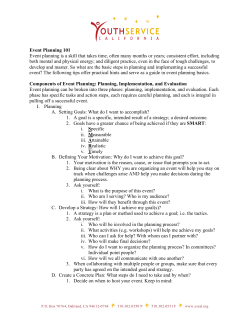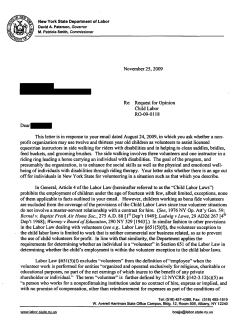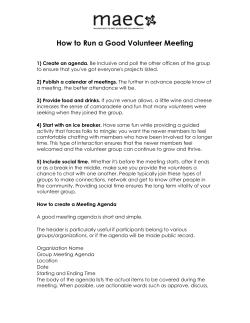
Session 3 – CME and AR
COMMUNITY MONITORING AND EVALUATION Content 1. Community Monitoring 2. Accountability Reporting What is Community Monitoring? • A process of measuring, collecting, recording, processing and periodic analysis of information by community members themselves • The end goal is to facilitate collective decision-making • Follows the “ActionReflection-Action (ARA)” framework Coverage of CM • Series of activities from 1st BA to AR and SET for DROM • Looks into: – BAP activities – BAP outputs – KC-NCDDP LGU and community commitments – Sub-project Implementation – Lessons Who are involved in CM? LGU/MCT (provides data) ACT, SRPMT (for guidance) Other Stakeholders (for other necessary data) MSIT (Multi-Stakeholders Inspectorate Team) – for SET Community Monitoring Volunteers Community Monitoring Community Members (approves plan discusses findings) Community Monitoring Activities Activities DROM areas Details Start of CM 1st BA PSA volunteers become CM volunteers, A Chair is selected; adopt BAP as basis of CM plan CM Volunteers Planning + 1 wk Identify key activities and outputs Prepare Monitoring Plan Prepare Work Plan Approval of Monitoring Plan + 1 more wk Community agrees on activities and outputs to be monitored Mid Cycle Monitoring After Municipal Forum based on CM Plan, CM Volunteers : collects & analyzes data Data Analysis 1 week before presentation CM Volunteers check gathered information Groups information based on Monitoring Plan Compares info from different sources Looks into reasons and anecdotes Community Monitoring Activities Activities DROM Details Mid Cycle reporting and updating of Monitoring Plan During SP implementation, depending on CM Volunteers, ACT and MCT agreement Mid-cycle findings discussed with all volunteers, ACT/MCT End of Cycle Monitoring After SP completion CM Volunteers collects data based on CM Plan CM Volunteers analyze data Data Analysis 1 week before Brgy AR CM Volunteers checks all gathered information Groups information based on Monitoring Plan Compares info from different sources Looks into reasons and anecdotes Data Gathering Guide Areas of Monitoring BAP Status Information Needs Activity Updates Outputs KC-NCDDP Commitments Technical Assistance Institutionalization Finance KC-NCDDP Implementation Source Interview, Group discussion, Review Reports, Survey MIAC, MCT, BLGU LGU reports MOA SIA Interview, Group Discussion, Review Reports ACT, MCT ACT/LGU Financial docs. KC-NCDDP Activities KC-NCDDP database Findings on completed subproject Who can help? LGU + other partners’ reports; Households BAP Outputs Sub-project Implementation How to get Info SPCR, Households Interview, Group Discussion, Review Reports, Review Database Review Reports, Interview, Survey BSPMC, ACT, MCT, Mun. Engineer CM Tools • • • • Monitoring Plan Work Plan Data Gathering Guide Guide Questions: Interviews, Consultations & Meetings Preparation of Community M&E Plans Community Monitoring Plan • Identify – Key activities based on BAP – Preparatory activities – BAP target outputs and beneficiaries – KC-NCDDP commitments – KC-NCDDP activities and outputs – Sub-projects to be implemented (after MIBF) • Where and how to get information Community Work Plan • Identify simplest ways to get needed data • Distribute tasks among volunteers • Set schedules for preparatory activities and data analysis • Identify other requirements (transportation cost) and how to address these Community Monitoring Plan Areas of Monitoring Req'd Key Acts. (Target) Accomp. by Mid of Cycle Expected Outputs/ Beneficiaries Source of Info 1st tranche requested BSPMC 35% Chair/ physical PIT accomp (Target) Accomp. by End of Cycle BAP /DANA/ and other rehab plans Commitments KC-NCDDP Implementation SPI Mid-cycle reporting and updating 100% physical accomp Remarks CM Work Plan Major Activities Mid Cycle Reporting and Updating End of Cycle Monitoring Specific Activities Meeting with the BSPMC When Who are Involved? March 2015 Members of the BSPMC, foreman, CM volunteers, CEF and TF Resources Needed Venue, food allowance Data Processing & Analysis Presentation of Findings • Present findings per monitoring area • CM Volunteers will solicit feedback from the community, LGU and other stakeholders • Identify how the monitoring data and feedback will affect KC-NCDDP implementation and in general, the development activities in the barangay • Use information for PSA revalidation and crafting of new BAP in next cycle ACCOUNTABILITY REPORTING What is Accountability Reporting? An end of cycle activity wherein both prioritized and non-prioritized barangays convene and discuss the highlights of their performances during the concluded cycle Objectives of AR • Inform community members on the status of SPs and for public disclosure of all aspects of the implementation including synthesis from GRS and actions taken Objectives of AR • Review and assessment of commitments made and delivered by the MLGU and other stakeholders • Identification of lessons in Cycle 1 implementation in the barangay and municipality, and recommendations for Cycle 2 Objectives of AR • Inform community members on the status of SPs and for public disclosure of all aspects of the implementation including synthesis from GRS and actions taken Objectives of AR • Review and assessment of commitments made and delivered by the MLGU and other stakeholders • Identification of lessons in Cycle 1 implementation in the barangay and municipality, and recommendations for Cycle 2 Key Message 1: The end goal of CM is to facilitate collective decision-making among community members; they decide for themselves what they want to monitor; why they want to monitor; and what are the standards for monitoring. Key Message 2: Accountability Reporting is a mechanism for transparency, accountability, and to demonstrate shared community responsibility to ensure that the project is implemented successfully. THANK YOU!
© Copyright 2025












